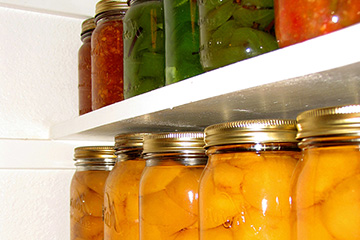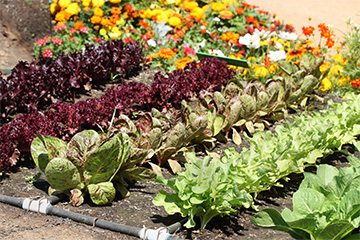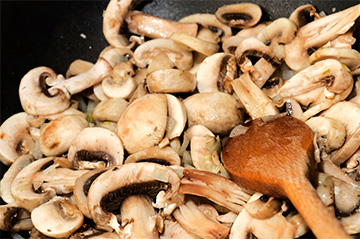
Be Smart, Be Safe With Food Preservation

As the gardening season approaches, consider planning not only which crops you would like to preserve but also the recipes you will use. The recipes you select may determine the success of your preservation efforts.
In fact, following old or unsafe recipes — especially untested ones found on the internet — is a common canning mistake. According to Newell Brands, the parent company for Ball and Kerr products, 99% of canning or seal failures are due to user error. Other common failures include:
- Using family methods for canning that are not safe
- Using the wrong jar size
- Improper processing methods
- Storing preserved foods in locations that are too hot, too cold or too moist
- Screwing the band onto the jar too tight
- Not adjusting for altitude
So let us help you preserve your food safely in the 21st century! We have many resources for recipes on our Kansas State University and University of Missouri Extension food preservation websites.
Tested canning recipes designate the size of the jar(s) you should use. For example, if a recipe calls for using pint jars, do not use a larger jar. Sometimes you can use a smaller jar, such as a 12-ounce or 8-ounce size, depending on the food. Just because your family uses a food in a larger quantity does not mean you can use a larger jar and can it safely.
High-acid foods, such as fruits, jams and jellies and pickles, can be safely canned using the boiling water bath method. Low-acid foods, such as plain vegetables and meat, must be canned in a pressure canner. A few foods, such as tomatoes, can be processed either way. Always adjust processing for your altitude of residence to insure safely processed food. Read “What’s Your Elevation?” to learn more, available at http://www.bookstore.ksre.ksu.edu/pubs/MF3172.pdf.
When you apply the lid and ring to the jar, screw the ring down just until it stops turning. Overtightening can cause the lid to buckle causing air inside the jar to push out. This will lead to seal failure.
Finally, store your safely canned jars of food in a cool, dry, dark location. Extensive temperature changes and high moisture environments can cause seal failures or unknown bacteria to grow.
Are you new to food preservation or need a refresher on these or other preservation tips? Contact your local extension office and request a hands-on class. In Missouri, go to https://extension.missouri.edu/programs/food-preservation. There are online resources to get you started. See https://www.rrc.k-state.edu/preservation/videos.html for videos.
Be smart and safe about preserving food at home. We are here to help!
Spring Gardening — Planning Ahead

Spring may seem far away, but now is a good time to start thinking about a fruit and vegetable garden if you have or want to have one!
Depending on the situation, home gardens can provide plenty of produce to preserve and enjoy long after the growing season is over. If you do want to raise a garden and preserve the food you grow, it is important to determine ahead of time which vegetables and varieties you want and how much of each you would like to grow so you have enough to eat some fresh as well as preserve some.
Also keep in mind the following important garden planning tips:
- Plan to rotate crops from one place to another each year to keep plants healthy.
- Visit your local extension office for more information on gardening in your area and to get your garden soil tested to optimize plant growth.
- Use safe gardening practices to ensure safe produce. Kansas State University (KSU) and MU Extension both have resources available on food safety for gardens, including a new KSU/MU Extension fact sheet that is also applicable to home gardens.
Source:
McLaurin, Wayne. n.d. “Spring Gardening: Getting Ready.” National Center for Home Food Preservation.
https://nchfp.uga.edu/tips/winter/prepare_spring_garden.html. (No longer available online.)
Freezing Mushrooms
 Mushrooms can be steamed or heated in fat in a fry pan. Steamed mushrooms will keep longer than those heated in fat.
Mushrooms can be steamed or heated in fat in a fry pan. Steamed mushrooms will keep longer than those heated in fat.
To prepare
Choose mushrooms free from spots and decay. Sort according to size. Wash thoroughly in cold water. Trim stem ends. If mushrooms are larger than 1 inch across, slice them or cut them into quarters.
To steam
Steamed mushrooms have better color if given an anti-darkening treatment first. To do this, dip for 5 minutes in a solution containing 1 teaspoon lemon juice or 1½ teaspoons citric acid to a pint of water.
Then steam whole mushrooms for 5 minutes, buttons or quarters for 3½ minutes and slices for 3 minutes. Cool promptly, drain and package, leaving ½ inch of headspace. Seal and freeze.
To heat in fry pan
Heat small quantities of mushrooms in margarine or butter in an open fry pan until almost done.
Cool in air or set pan in which you cooked the mushrooms in cold water. Pack into containers, leaving ½ inch of headspace. Seal and freeze.
Source:
National Center for Home Food Preservation. n.d. “Freezing: Mushrooms.” https://nchfp.uga.edu/how/freeze/mushroom.html.